- Joined
- Feb 2, 2011
- Messages
- 2,055
NEW RELEASES FOR SEPTEMBER 2024
THE ANCIENTS
ARMIES AND ENEMIES OF GREECE AND MACEDONIA
THE ACHAEMENID PERSIAN ARMY
ACHAEMENID PERSIAN SCYTHED CHARIOT
The 4 horse scythed chariots were used by the later Achaemenid Persians.
Scythed chariots were drawn by four armoured horses and manned by a single armoured driver. It was important for the vehicle to build up speed, as they were vulnerable to swift pre-emptive attacks by light troops.
Once the chariot was galloping towards its target, the driver would often bail out for his own safety, which unfortunately made it likely that the horses would miss or shy away from the target.
If they did make contact, the chariots would cause immense damage but would more or less destroy themselves in the collision.
Generally formed infantry bodies could stand firm after such contact, unless the chariots were closely supported, which they all too often were not.
Cavalry might have been easier to break than solid infantry bodies, but were not used, perhaps because the cavalry could easily have avoided their charge.
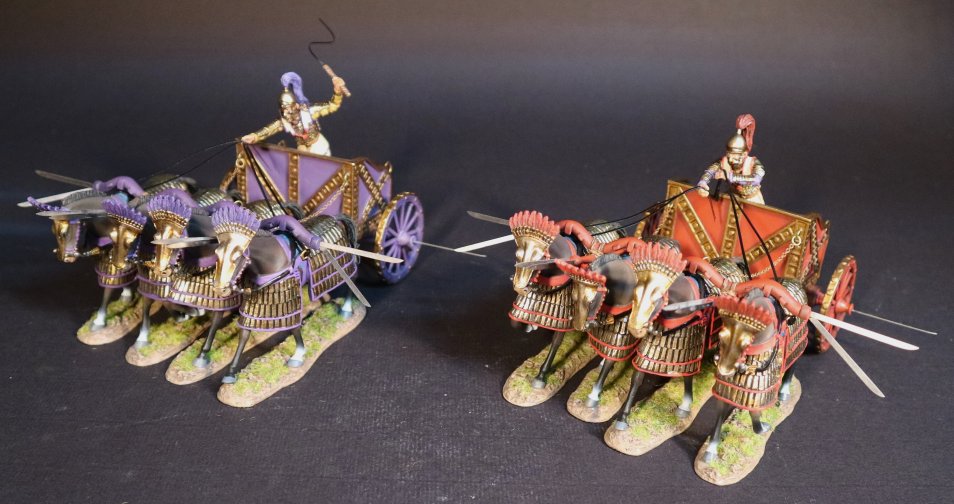
Xenophon’s “Kyropaidia” provides us with the best description of these items.
It is described as having heavy wheels with studded rims, a broad wheelbase for stability, and two poles.
Some decriptions refer to a closed back with a rear door, but others with an open back, but a simple bench seat to one side.
Diodoros describes the chariots at Gaugamela with 27 inch blades at the ends of the yokes, and blades on the axle ends.
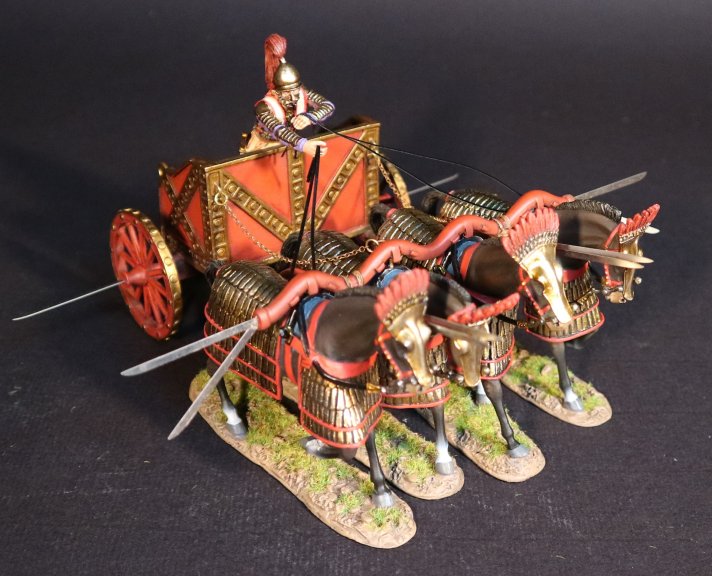
AP-100A
ARMIES AND ENEMIES OF ANCIENT GREECE AND MACEDONIA,
THE ACHAEMENID PERSIAN EMPIRE,
PERSIAN SCYTHED CHARIOT
Xenophon describes Persian charioteers, as wearing a cuirass, armpieces and helmet, with only the eyes showing. It is believed that no armour was worn below the waist as this was protected by the body of the chariot. The helmet is believed to have cheek pieces which would reflect a Greek influence.
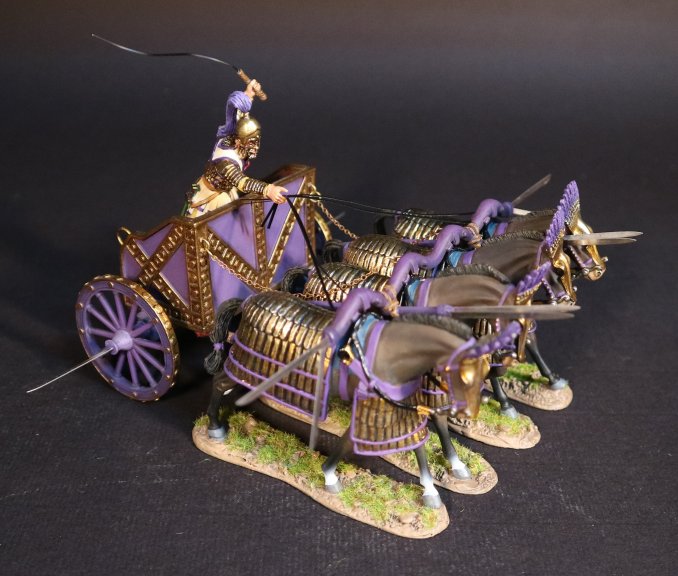
AP-100B
ARMIES AND ENEMIES OF ANCIENT GREECE
AND MACEDONIA,
THE ACHAEMENID PERSIAN EMPIRE,
PERSIAN SCYTHED CHARIOT
MACEDONIAN HYPASPISTS
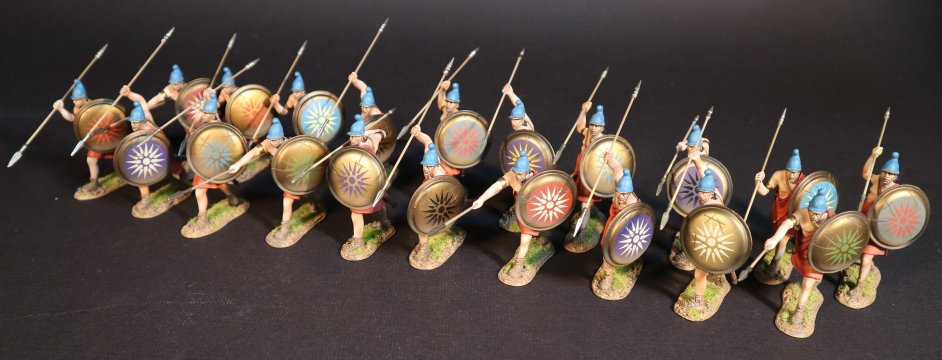
The Macedonian Hypaspists were positioned on the flank of the Phalangites phalanx.
Their own flanks were protected by light infantry and cavalry.
Their job was to guard the flanks of the large and unwieldy pike phalanx. The armoured phalangites with their sarissas were not particularly agile or able to turn quickly, so hypaspists were positioned to prevent and protect attacks on the vulnerable sides of the phalanx formation.
Their role was vital to the success of the Macedonian tactics because the phalanx was all but invulnerable from the front, and with its layers of iron spikes moving in unison, were used as the anvil in their hammer and anvil tactics. The Companion cavalry was the hammer that smashed the enemy against the anvil of thousands of iron spikes.
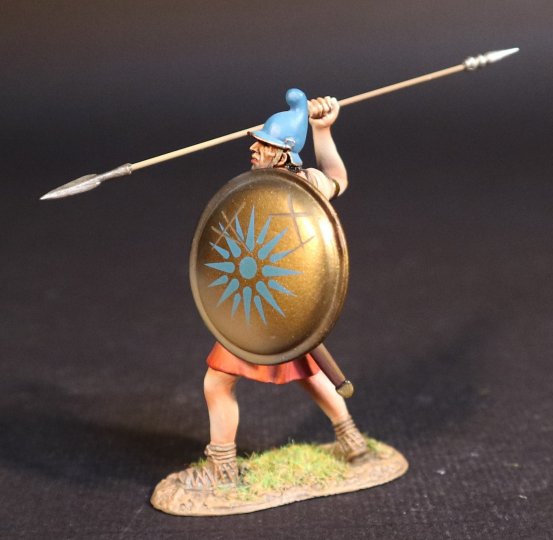
MAC-33A
ARMIES AND ENEMIES OF ANCIENT GREECE AND MACEDONIA,
THE MACEDONIANS,
MACEDONIAN HYPASPIST
The Hypaspists protected the vulnerable phalanx flank, and were able to conduct maneuvers and use tactics, which owing to their hoplite panoply of weapons, would have been impossible to be performed by the phalangites.
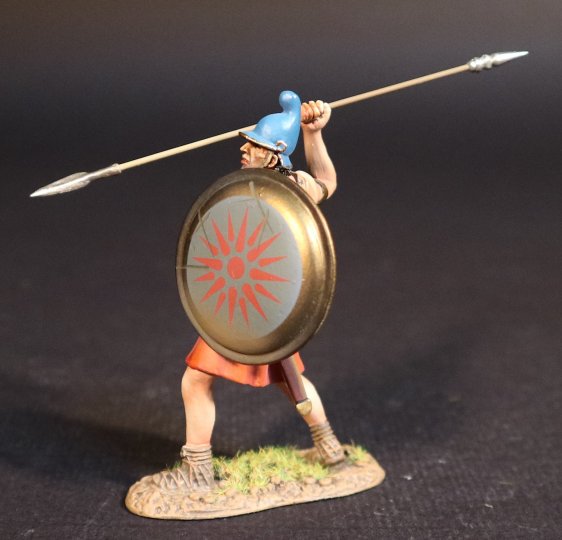
MAC-33B
ARMIES AND ENEMIES OF ANCIENT GREECE AND MACEDONIA,
THE MACEDONIANS,
MACEDONIAN HYPASPIST
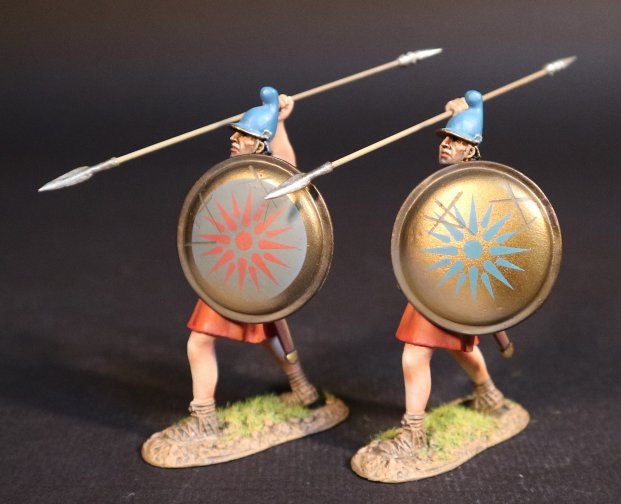
MAC-33N
ARMIES AND ENEMIES OF ANCIENT GREECE AND MACEDONIA,
THE MACEDONIANS,
MACEDONIAN HYPASPISTS
ARMIES AND ENEMIES OF THE NEW KINGDOM EGYPTIANS
NUBIAN MERCENARIES
The country of Nubia was divided into distinct regions such as Yam, Irthet and Wawat, but all the peoples were known to the Egyptians as the “vile” Kush, which was the Egyptian name for the country.
These tribesmen were never any real threat to Egypt as they lacked any large scale organisations and were only at their best when actually fighting as auxiliaries in the Egyptian forces.
The success of the Egyptian infantry units was mainly due to the archery sections which were composed in the main, of Nubians.
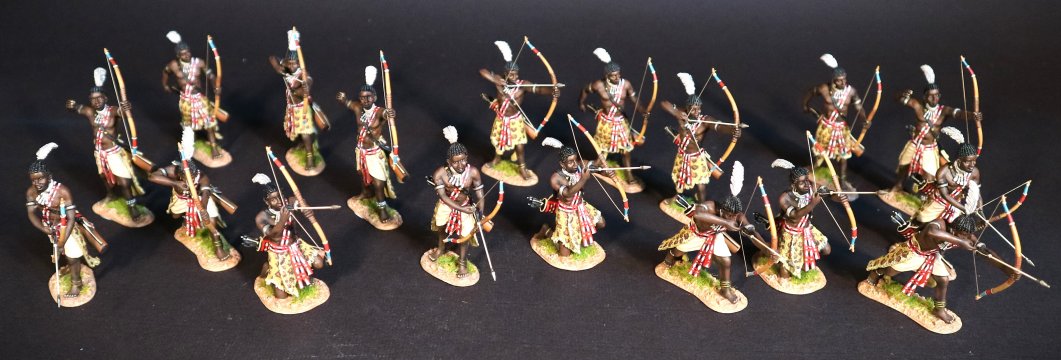
Nubia had been conquered during the Middle Kingdom, but fell to the king of Kush in the Hyksos period and was finally re-conquered during the New Kingdom. This secured the southern frontier and controlled the Nubian gold mines. Nubia was settled with Egyptian colonists in forts and “temple towns” and governed by a viceroy.
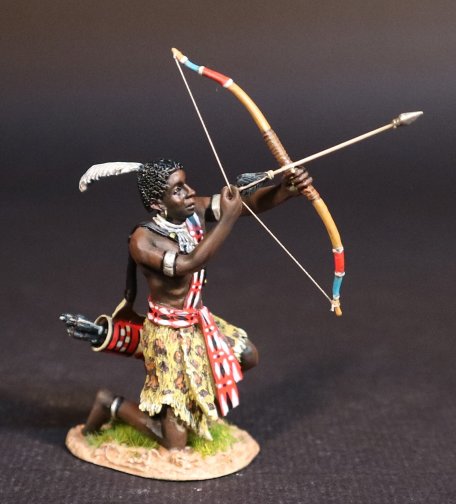
NKE-16
THE ANCIENTS,
NEW KINGDOM EGYPTIANS,
THE BATTLE OF KADESH 1274BC,
NUBIAN MERCENARY
Nubian troops had been an important part of the Egyptian army since the old Kingdom. Nubian tribes included the famous Medja who were regarded by the Egyptians as the best scouts and skirmishers. They were known for wearing leopard and lion skin kilts and had ostrich feathers in their hair.
The Medjway were very highly regarded by the Egyptians as they seemed to have a natural affinity for the military life.
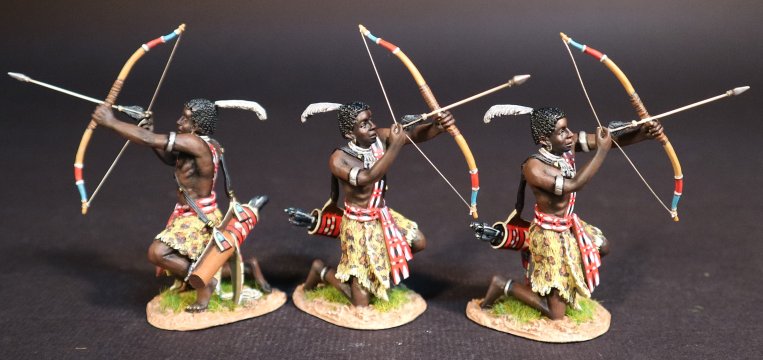
NKE-16N
THE ANCIENTS,
NEW KINGDOM EGYPTIANS,
THE BATTLE OF KADESH 1274BC,
NUBIAN MERCENARIES
These figures will of course be suitable for the Trojan War series as King Memnon’s army.
Memnon was the King of the Ethiopians, who after the death of the Trojan warrior Hector, went to assist his uncle Priam, against the Greeks.
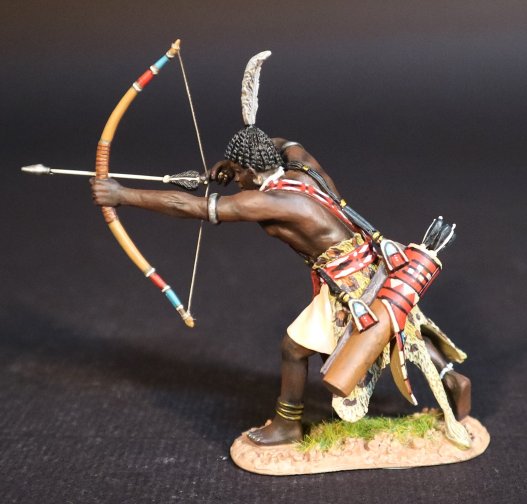
NKE-17
THE ANCIENTS,
NEW KINGDOM EGYPTIANS,
THE BATTLE OF KADESH 1274BC,
NUBIAN MERCENARY
He arrived with a great army, and performed prodigies of valour, but was slain by the Greek hero Achilles.
According to tradition, Zeus , the king of the gods, was moved by the tears of Eos and bestowed immortality upon Memnon. His companions were changed into birds, called Memnonides, that came every year to fight and lament over his grave
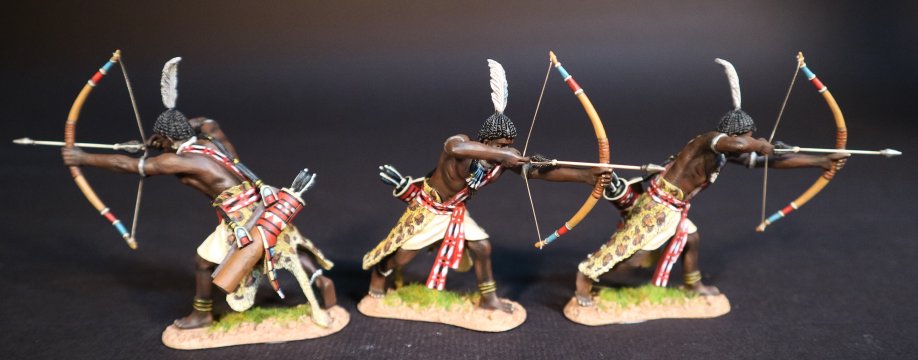
NKE-17N
THE ANCIENTS,
NEW KINGDOM EGYPTIANS,
THE BATTLE OF KADESH 1274BC,
NUBIAN MERCENARIES

ARMIES AND ENEMIES OF ANCIENT ROME
THE CARTHAGINIANS
THE BATTLE OF ZAMA 202BC
NORTH AFRICAN ALLIES
Although initially the Carthaginian army was composed only of Citizens of Phoenician origin, it saw increased recruitment of contingents of mercenaries and allies a necessity in order to realize the policy of imperial expansion.
This use of mercenaries saved the metropolitan population from heavy casualties that were not easily replaceable, and it also reflected the Carthaginian concept of war, which was considered simply as an extension of business.
With the enlargement of Punic economic interests the army became more exclusively mercenary and progressively came to include almost all the peoples of the central and western Mediterranean area.
The largest single component of the Punic army usually comprised soldiers recruited or impressed from subject Libyans. These are often referred to as “Africans”, or Liby-Phoenicians. These were mercenaries or in some cases conscripts, subject to service from the tenants of the large African estates.
Eventually these mercenaries were no longer simply troops hired for a single campaign and discharged after a few months service, as had originally been the case, especially during the first Punic War. They were now a professional standing army seasoned by long years of warfare, under the command of skilled generals such as Hamilcar Barca and his sons.
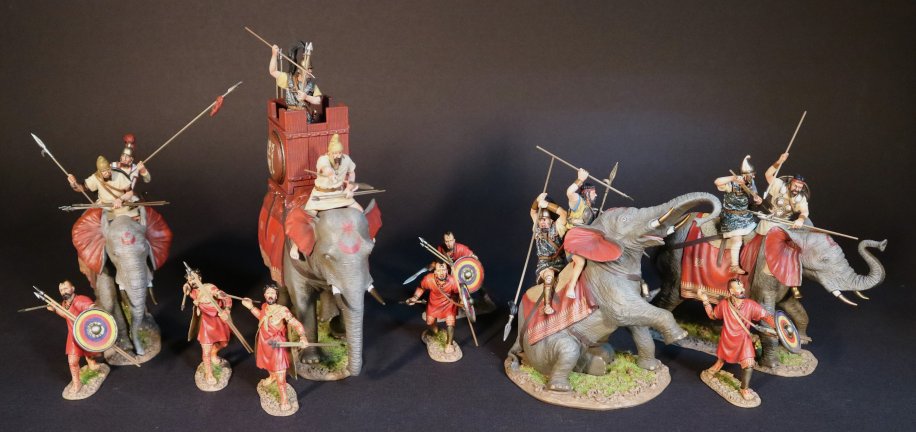
Among the North African allies were the subjected Libyans of the Marmarica, which formed a major part of the light infantry. These were mainly made up from several tribes, Nasamones, Macae from the Cynips river, the tribes of Barce, the Autololes, the ferocious Adyrmachidae, and the Garamantians.
ADYRMACHID WARRIORS
This Libyan tribe called the Adyrmachidae were described as carrying a buckler of many colours ,a sword in the shape of a sickle and would wear a single greave on the left leg. Warriors would have their head shaved except for a central plaited crest, often with a crescent amulet fastened to hang on his brow. Nose rings were also typical for many punic cultures.

CTSK-03
ARMIES AND ENEMIES OF ANCIENT ROME,
THE CARTHAGINIANS,
THE BATTLE OF ZAMA 202BC,
ADYRMACHID WARRIORS
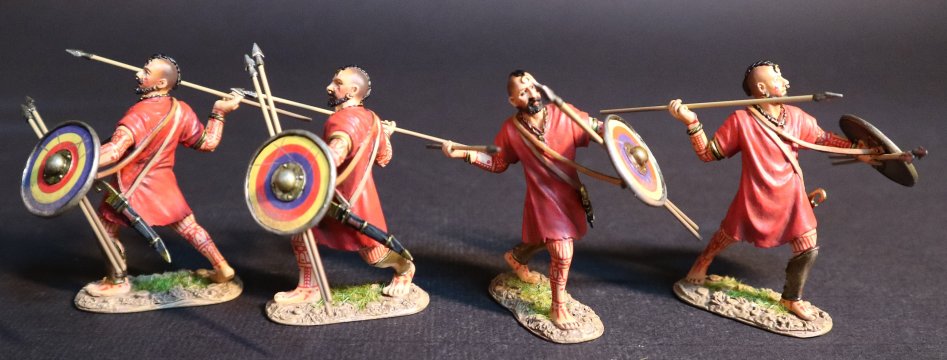
CTSK-03N
ARMIES AND ENEMIES OF ANCIENT ROME,
THE CARTHAGINIANS,
THE BATTLE OF ZAMA 202BC,
ADYRMACHID WARRIORS.
**PLEASE CONTACT YOUR LOCAL DEALER FOR FURTHER INFORMATION**
THE ANCIENTS
ARMIES AND ENEMIES OF GREECE AND MACEDONIA
THE ACHAEMENID PERSIAN ARMY
ACHAEMENID PERSIAN SCYTHED CHARIOT
The 4 horse scythed chariots were used by the later Achaemenid Persians.
Scythed chariots were drawn by four armoured horses and manned by a single armoured driver. It was important for the vehicle to build up speed, as they were vulnerable to swift pre-emptive attacks by light troops.
Once the chariot was galloping towards its target, the driver would often bail out for his own safety, which unfortunately made it likely that the horses would miss or shy away from the target.
If they did make contact, the chariots would cause immense damage but would more or less destroy themselves in the collision.
Generally formed infantry bodies could stand firm after such contact, unless the chariots were closely supported, which they all too often were not.
Cavalry might have been easier to break than solid infantry bodies, but were not used, perhaps because the cavalry could easily have avoided their charge.

Xenophon’s “Kyropaidia” provides us with the best description of these items.
It is described as having heavy wheels with studded rims, a broad wheelbase for stability, and two poles.
Some decriptions refer to a closed back with a rear door, but others with an open back, but a simple bench seat to one side.
Diodoros describes the chariots at Gaugamela with 27 inch blades at the ends of the yokes, and blades on the axle ends.

AP-100A
ARMIES AND ENEMIES OF ANCIENT GREECE AND MACEDONIA,
THE ACHAEMENID PERSIAN EMPIRE,
PERSIAN SCYTHED CHARIOT
Xenophon describes Persian charioteers, as wearing a cuirass, armpieces and helmet, with only the eyes showing. It is believed that no armour was worn below the waist as this was protected by the body of the chariot. The helmet is believed to have cheek pieces which would reflect a Greek influence.

AP-100B
ARMIES AND ENEMIES OF ANCIENT GREECE
AND MACEDONIA,
THE ACHAEMENID PERSIAN EMPIRE,
PERSIAN SCYTHED CHARIOT
MACEDONIAN HYPASPISTS

The Macedonian Hypaspists were positioned on the flank of the Phalangites phalanx.
Their own flanks were protected by light infantry and cavalry.
Their job was to guard the flanks of the large and unwieldy pike phalanx. The armoured phalangites with their sarissas were not particularly agile or able to turn quickly, so hypaspists were positioned to prevent and protect attacks on the vulnerable sides of the phalanx formation.
Their role was vital to the success of the Macedonian tactics because the phalanx was all but invulnerable from the front, and with its layers of iron spikes moving in unison, were used as the anvil in their hammer and anvil tactics. The Companion cavalry was the hammer that smashed the enemy against the anvil of thousands of iron spikes.

MAC-33A
ARMIES AND ENEMIES OF ANCIENT GREECE AND MACEDONIA,
THE MACEDONIANS,
MACEDONIAN HYPASPIST
The Hypaspists protected the vulnerable phalanx flank, and were able to conduct maneuvers and use tactics, which owing to their hoplite panoply of weapons, would have been impossible to be performed by the phalangites.

MAC-33B
ARMIES AND ENEMIES OF ANCIENT GREECE AND MACEDONIA,
THE MACEDONIANS,
MACEDONIAN HYPASPIST

MAC-33N
ARMIES AND ENEMIES OF ANCIENT GREECE AND MACEDONIA,
THE MACEDONIANS,
MACEDONIAN HYPASPISTS
ARMIES AND ENEMIES OF THE NEW KINGDOM EGYPTIANS
NUBIAN MERCENARIES
The country of Nubia was divided into distinct regions such as Yam, Irthet and Wawat, but all the peoples were known to the Egyptians as the “vile” Kush, which was the Egyptian name for the country.
These tribesmen were never any real threat to Egypt as they lacked any large scale organisations and were only at their best when actually fighting as auxiliaries in the Egyptian forces.
The success of the Egyptian infantry units was mainly due to the archery sections which were composed in the main, of Nubians.

Nubia had been conquered during the Middle Kingdom, but fell to the king of Kush in the Hyksos period and was finally re-conquered during the New Kingdom. This secured the southern frontier and controlled the Nubian gold mines. Nubia was settled with Egyptian colonists in forts and “temple towns” and governed by a viceroy.

NKE-16
THE ANCIENTS,
NEW KINGDOM EGYPTIANS,
THE BATTLE OF KADESH 1274BC,
NUBIAN MERCENARY
Nubian troops had been an important part of the Egyptian army since the old Kingdom. Nubian tribes included the famous Medja who were regarded by the Egyptians as the best scouts and skirmishers. They were known for wearing leopard and lion skin kilts and had ostrich feathers in their hair.
The Medjway were very highly regarded by the Egyptians as they seemed to have a natural affinity for the military life.

NKE-16N
THE ANCIENTS,
NEW KINGDOM EGYPTIANS,
THE BATTLE OF KADESH 1274BC,
NUBIAN MERCENARIES
These figures will of course be suitable for the Trojan War series as King Memnon’s army.
Memnon was the King of the Ethiopians, who after the death of the Trojan warrior Hector, went to assist his uncle Priam, against the Greeks.

NKE-17
THE ANCIENTS,
NEW KINGDOM EGYPTIANS,
THE BATTLE OF KADESH 1274BC,
NUBIAN MERCENARY
He arrived with a great army, and performed prodigies of valour, but was slain by the Greek hero Achilles.
According to tradition, Zeus , the king of the gods, was moved by the tears of Eos and bestowed immortality upon Memnon. His companions were changed into birds, called Memnonides, that came every year to fight and lament over his grave

NKE-17N
THE ANCIENTS,
NEW KINGDOM EGYPTIANS,
THE BATTLE OF KADESH 1274BC,
NUBIAN MERCENARIES

ARMIES AND ENEMIES OF ANCIENT ROME
THE CARTHAGINIANS
THE BATTLE OF ZAMA 202BC
NORTH AFRICAN ALLIES
Although initially the Carthaginian army was composed only of Citizens of Phoenician origin, it saw increased recruitment of contingents of mercenaries and allies a necessity in order to realize the policy of imperial expansion.
This use of mercenaries saved the metropolitan population from heavy casualties that were not easily replaceable, and it also reflected the Carthaginian concept of war, which was considered simply as an extension of business.
With the enlargement of Punic economic interests the army became more exclusively mercenary and progressively came to include almost all the peoples of the central and western Mediterranean area.
The largest single component of the Punic army usually comprised soldiers recruited or impressed from subject Libyans. These are often referred to as “Africans”, or Liby-Phoenicians. These were mercenaries or in some cases conscripts, subject to service from the tenants of the large African estates.
Eventually these mercenaries were no longer simply troops hired for a single campaign and discharged after a few months service, as had originally been the case, especially during the first Punic War. They were now a professional standing army seasoned by long years of warfare, under the command of skilled generals such as Hamilcar Barca and his sons.

Among the North African allies were the subjected Libyans of the Marmarica, which formed a major part of the light infantry. These were mainly made up from several tribes, Nasamones, Macae from the Cynips river, the tribes of Barce, the Autololes, the ferocious Adyrmachidae, and the Garamantians.
ADYRMACHID WARRIORS
This Libyan tribe called the Adyrmachidae were described as carrying a buckler of many colours ,a sword in the shape of a sickle and would wear a single greave on the left leg. Warriors would have their head shaved except for a central plaited crest, often with a crescent amulet fastened to hang on his brow. Nose rings were also typical for many punic cultures.

CTSK-03
ARMIES AND ENEMIES OF ANCIENT ROME,
THE CARTHAGINIANS,
THE BATTLE OF ZAMA 202BC,
ADYRMACHID WARRIORS

CTSK-03N
ARMIES AND ENEMIES OF ANCIENT ROME,
THE CARTHAGINIANS,
THE BATTLE OF ZAMA 202BC,
ADYRMACHID WARRIORS.
**PLEASE CONTACT YOUR LOCAL DEALER FOR FURTHER INFORMATION**

